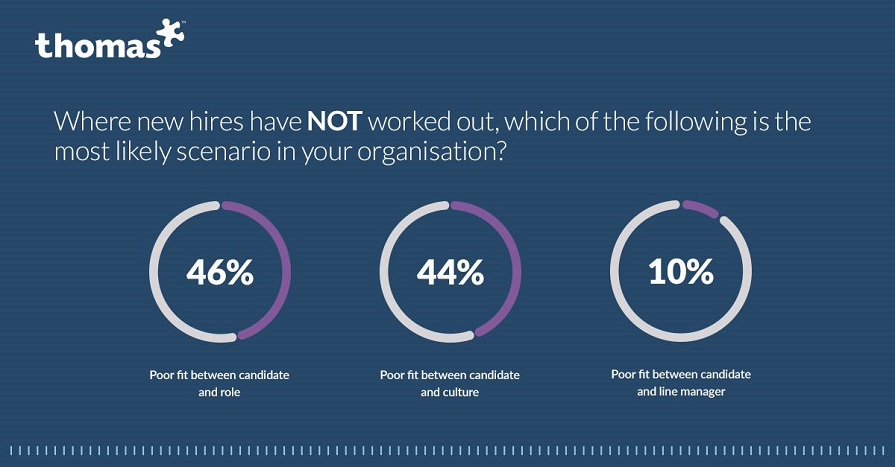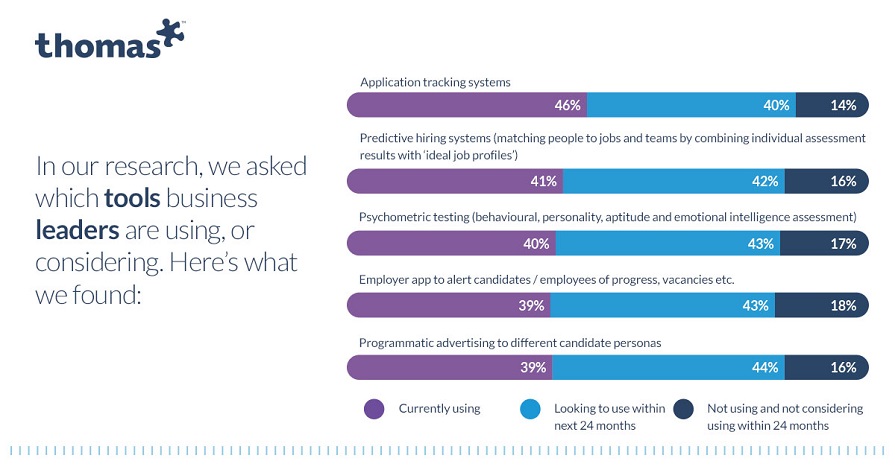
Our 2021 Research Report highlighted the challenges around recruitment that are currently leading to an astonishing amount of hires not working out (more than half!)
In an increasingly connected world, business leaders can’t afford to endanger relationships between their staff and managers – reputations are at stake and word travels at lightning speed across social media and chat forums. It’s vital that organisations understand why vacancies are filled with the wrong people, and why the right people might not want to stay. We’re going back to our research to find out why.
We surveyed 500 HR and talent leaders of different sized companies across different sectors and learned that there are three key reasons why successful hiring is so hard to achieve. This is what recruiters attribute their issues to:
- Poor fit between candidate and role
- Poor fit between candidate and culture
- Poor fit between candidate and line manager

Ultimately, 90% of the struggle in successful hiring comes down to culture and role. Going further still, the research shows us that a range of systematic issues are the root cause for almost half of these failed hires. The top five offenders are:
- Complicated, elongated recruitment processes (an issue for 31%)
- Poor candidate experience (31%)
- Inability to test culture or role fit (31%)
- Lack of transparency in decision-making (30%)
- Over reliance on gut instinct (29%)
All of these are undermining trust in recruitment. While remote hiring is popularly cited as a problem currently, in reality it’s just a smokescreen obscuring some troubling, long standing issues.
The positive thing here is that HR leaders are more than aware of these challenges. The research shows that they know what steps to take to get past them, so they’re able to harness the opportunities for team building and business reshaping that will define the COVID recovery period.
The need to speed up processes, cut costs, reduce bias and look beyond CVs (all while improving candidate experience) offer some insight into how recruiters intend to transform their part of the business over the coming year.
What we talk about when we talk about culture
Company culture is always hard to pin down. But it matters – regularly being cited as one of the deciding factors in the success or failure of a hire.
The Harvard Business Review explored culture as a shared, pervasive, enduring and implicit thing, existing across organisations. And describes it as an ‘elusive lever, because much of it is anchored in unspoken behaviours, mindsets, and social patterns’.
Our Head of Science, Jayson Darby, suggests that culture should reflect the individual more than that:
“Cultures and sub-cultures emerge all the time when groups of people interact, it’s the same in any business. Trying to measure how someone 'fits' a culture overall can be challenging. However, if someone enjoys their job (good person-job fit) and works well with the people around them (good person-team fit), they are likely to be positive contributors to the overall company culture.”
Whatever’s the case, trying to find people that fit your culture is hard. And harder still without the right tools and technology that gauge person-to-job fit. Psychometric assessments can measure that with quantitative outcomes.
What are the key priorities for recruitment over the next 12 months?
Just 1% of the people we surveyed think that it’s not at all important to improve the quality of recruitment systems and processes. Which means they’ve either got advanced tools in the building, or are really brave.
By contrast, 55% think it’s important, and 30% critical. This maps to an overriding sense of a need for evolution in hiring systems and a different overall approach in recruitment. One which, if executed well, should close that trust gap that’s undermining hiring.
Predictive hiring tools can help
Technological solutions and tactical approaches that will solve many of today’s recruitment problems are either being used, or on the way, for the vast majority of our respondents. Key here are things like predictive hiring and psychometric testing, which avoid the culture and role clashes that lead to a lot of failed hires. As well as apps to improve the candidate side of things, and blind CVs to remove the unconscious bias that troubles so many businesses.
In our research, we asked which tools business leaders are using, or considering. Here’s what we found:

Yet, while these numbers are positive, in many cases they’re intentions. To turn good practice into reality and close the trust gap, businesses need to understand their readiness for technology – and be willing to invest.
Key takeaways:
- 85% of our respondents think it’s important to improve systems and processes to some degree
- Predictive hiring and psychometric testing are seen as vital evolutions in recruitment
- The top priority over the coming 12 months is improving the quality of hires (38% agree)
Restore trust in the process by increasing transparency across the business and these challenges can be met. Allow things to continue and they’ll slide further with every hire that doesn’t work out.
Want to know more? Download the full report, Spotlight on Recruitment 2021: Mind the Trust Gap to understand more about fixing broken recruitment.




